SaaS Pricing Models: Which is Right for Your Product?
You don’t need us to tell you that selling a SaaS product is hard work. There are so many factors to think about to get it right, and a lot of things that play into the success of the product – with your SaaS pricing model being one of them.
The way you price your product can be make or break. When launching a product, it can be the difference between lift-off 🚀and a false start 🚫. Getting your pricing model right can help you attract the right customers and position your product properly.
The tricky thing is that there are lots of SaaS pricing models to choose from, and they can all be good depending on the situation. There’s no one-size-fits-all pricing model, meaning that you’re going to have to do some research and product discovery to identify the right one for you.
That means, to make your SaaS pricing model a success, you’re going to have to put the effort in. Amazingly, research suggests that many businesses don’t do that. Paddle found that companies spend just six hours on their pricing. Not six hours a month, or even six hours a year – just six measly hours throughout the entire company’s history. You’re going to want to invest a bit more time than this to ensure that you get it right.
That’s where we can help. Here’s the lowdown on the main SaaS pricing models you need to care about – the contenders you should choose from. Now before we step even one foot further, it’s important to stress that your SaaS pricing model will be heavily influenced by your pricing strategy. That makes a lot of sense: if your pricing model is your how, the nuts and bolts of your pricing; your pricing strategy is the why, the framework. It’s worth making sure you’re clued up on product pricing strategies. Check out the article below to give yourself a refresher 🔽:
Product Pricing Strategies: Choosing the Right Approach for You
What are SaaS pricing models?
Now, when you’re selling software-as-a-service, 99% of the time, you’ll be using subscription-based pricing. This is where customers pay up every month or even annually to ensure they have continuous access to the software. SaaS pricing isn’t as simple as slapping a one-off price tag on the product and calling it a day – it’s not a gallon of milk from the grocery store.
This subscription-based pricing doesn’t tell the whole story of how you’re pricing your product though. SaaS pricing models help to better define the method you’re using to charge for your product. See, you can choose approaches like charging per feature, or by user, among many other options, so you need to figure out which one best suits your service and the audience you want to attract.
In a nutshell, SaaS pricing models are the different ways you can charge customers for your product. The pricing model you choose determines the relationship between your product’s value and what your customers pay for it. It’s vital that you get it right.
Why is your SaaS pricing model important?
Customers are picky, as they should be. Different types of users are drawn to different pricing models based on their needs, industry, and budgets. Pick the right model, and your product becomes irresistible. Get it wrong, and you’ll drive potential customers straight into the arms of your competitors.
Say you offer an online file-sharing software like Dropbox. Users of these types of products are used to and like the tiered pricing model. If you come in with a product that uses a user-based pricing model, it might not appeal to the customers and sink like a stone, even if everything else about your product is amazing.
Choosing the right SaaS pricing model aligns your product with customer expectations, helping you build trust, cater to needs, and offer value. People tend to stick with what they know, so if your pricing model is way out of left field compared to your competitors, you might unintentionally scare off your audience.
Your SaaS pricing model also helps with your product positioning, which is essential for branding your product correctly. The way you price your product needs to align with the market position you want to occupy. If you mess it up, you’ll send the wrong impression.
For example, if you’re looking to position your SaaS product as a premium option, you may confuse your audience by running a freemium, budget-friendly pricing model.
Product positioning is a whole different ballgame in itself. We chatted with positioning expert April Dunford to learn more. You can check out the free webinar below:
[WEBINAR] The Secret to Product Positioning with April Dunford.
How to decide on a SaaS pricing model?
The SaaS pricing model you choose is one of the most important decisions you can make about your product, so how on earth do you get it right? The simple answer is research.
Get useful feedback from your customer teams and focus on continuous discovery to ensure you keep learning. You’re going to have to spend time learning about your customers and the market you’re in. A deeper understanding of their pain points and needs as well as knowledge of what your competitors are doing will help guide you in the right direction.
The best SaaS pricing model depends on your situation – there’s no one-size-fits-all, and they can all be great options if used in the right scenario.
Here’s some steps to work through to help ensure that your SaaS pricing model is the best choice for you.
1. Start with user and market research
Product discovery is going to be the backbone of finding the right SaaS pricing model for you. You need to understand what your customers value and what they’re willing to pay for. By solving customer problems, not feature requests, and by figuring out what they want and what they’re used to, you’ll be able to choose a pricing model that matches this need. Conduct surveys, test pricing options, and see how your users react.
2. Test it
Don’t treat your SaaS pricing model as a “set it and forget it” decision. Try different options – freemium, tiered pricing, or usage-based – and see which ones stick. If you’ve found that something isn’t working, you have the freedom to change it. You wouldn’t stick with a feature that wasn’t performing, so don’t feel like you have to do the same with your pricing when all the signs say it’s wrong.
This experimentation is a key part of product price testing, and there are many different ways you can gather feedback and test your price points. Check out the article below to learn more about what you can do:
3. Iterate and optimize
You won’t get your pricing right on the first try – no matter how much of a perfectionist you are. Your pricing model could be bang on, but your price points may not. You may also find that after a few years, your pricing no longer works as your business grows and scales. Don’t worry, pricing evolves just as your product does. You shouldn’t feel pressured to stay still.
Pay attention to customer feedback, customer churn rates, product adoption metrics, and sales data, and adjust your pricing model as and when you need to. What’s working now, may not work in the future.
4. Align with company goals
Your pricing model should match your business objectives and value proposition. If you’re focused on growth, a lower-cost model might work. If profitability is the goal, consider premium tiers or usage-based pricing to maximize revenue.
This also relates to how you want your product to be perceived. If you want to have a premium feel, your pricing model needs to link to this. A freemium pricing model won’t make your product feel exclusive, but a tiered SaaS pricing model might.
Remember, the key is to stay flexible. Pricing is a living thing that needs regular tweaking to remain effective.
What are the different SaaS pricing models?
We’ve made it very clear that there are multiple different SaaS pricing models, so what are they? Here are the details on the key ones you should choose from to help you make your own decision.
Freemium SaaS pricing model
Pros
- Low barrier to entry – easy for users to sign up and test.
- Word-of-mouth marketing – more users means more exposure.
- Creates a pool of potential paying customers over time.
Cons
- Conversion rates can be low (you’ll have a lot of free users).
- There’s a risk of giving away too much with the free plan.
- Heavy usage of free plans can drain resources.
Freemium is a well-trusted SaaS pricing model that can be used to hook in users and get them to explore your product. With this approach, you offer a limited version of your product for no cost. Without having to spend a dime, users will get access to valuable services, but that blocks off certain features to encourage them to upgrade to the full package.
This approach removes the barrier to entry, making it much smoother for customers to get started with your product, allowing them to see the value of your product early. It’s a great way to maintain an active adoption rate, keeping potential paying customers in your pipeline.
A pricing model that’s evolved from freemium is the reverse trial. This is a method where you flip the freemium approach upside down and at first offer an all-access version of your product for free during a trial period. Once the trial ends you remove access to those premium features yet continue to provide the basic, free version. This gives users a chance to test out the full suite of features, reducing the time to value (TTV), and hopefully getting users hooked on these products so that they’re inclined to pay.
This type of SaaS pricing model is ideal for products that want to scale fast and that benefit the most from a large user base. Examples include social media platforms, communication tools, and collaboration software. Grammarly is a great example of freemium SaaS pricing, as you can use the tool for free, but to get more features, you’ll need to upgrade to the paid version.
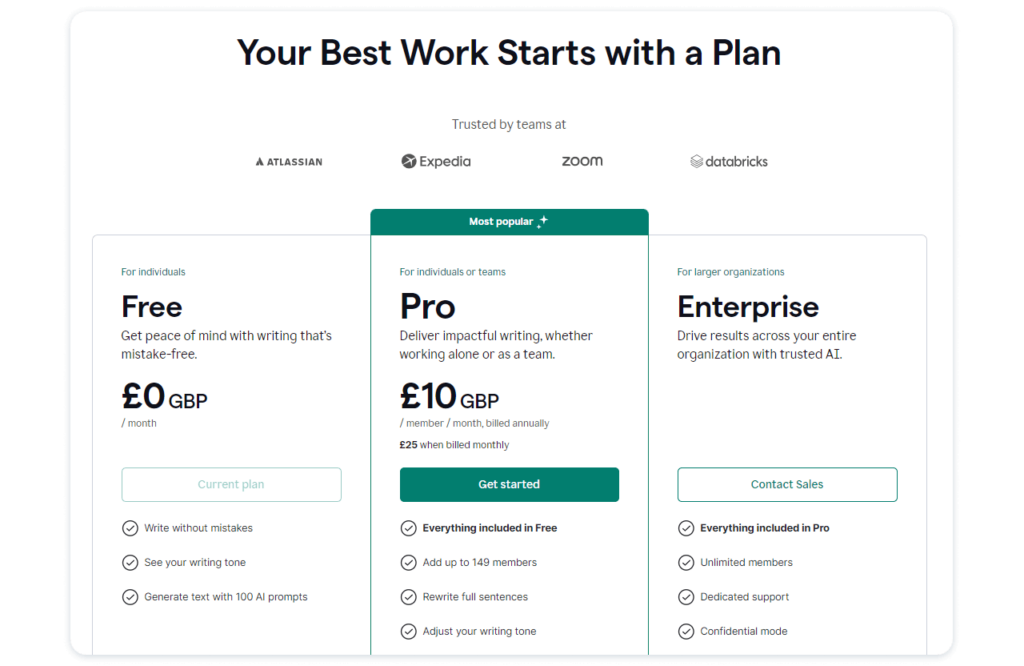
Tiered SaaS pricing model
Pros
- Caters to a wide audience with varied budgets.
- Encourages users to upgrade as their business grows.
- Opportunity to upsell additional features in higher tiers.
Cons
- Too many tiers can confuse customers.
- Pricing tiers need balancing to avoid overlap.
- Customers at the lower end may never feel the need to upgrade.
The tiered SaaS pricing model is where you offer different versions of your product, with higher, more expensive tiers including more services and features. It’s like offering your customers a pricing ladder that they can climb to access better features and additional perks.
This approach is ideal for SaaS businesses that want to appeal to a wide range of customers that have varying budgets, as you’ll be able to attract budget-focused users on your lower tiers and more premium customers on your top tiers. This approach also gives your customers a clear pipeline to follow – you can start them on the lowest tier and then once they become more comfortable and trusting towards your product, you can introduce them to new features found in different tiers.
A great example of the tiered pricing model is MailChimp. Here they offer three different tiers – in addition to a freemium option. When offering tiered prices, they make it clear what’s available on each plan, ensuring that customers get the right option for their needs.
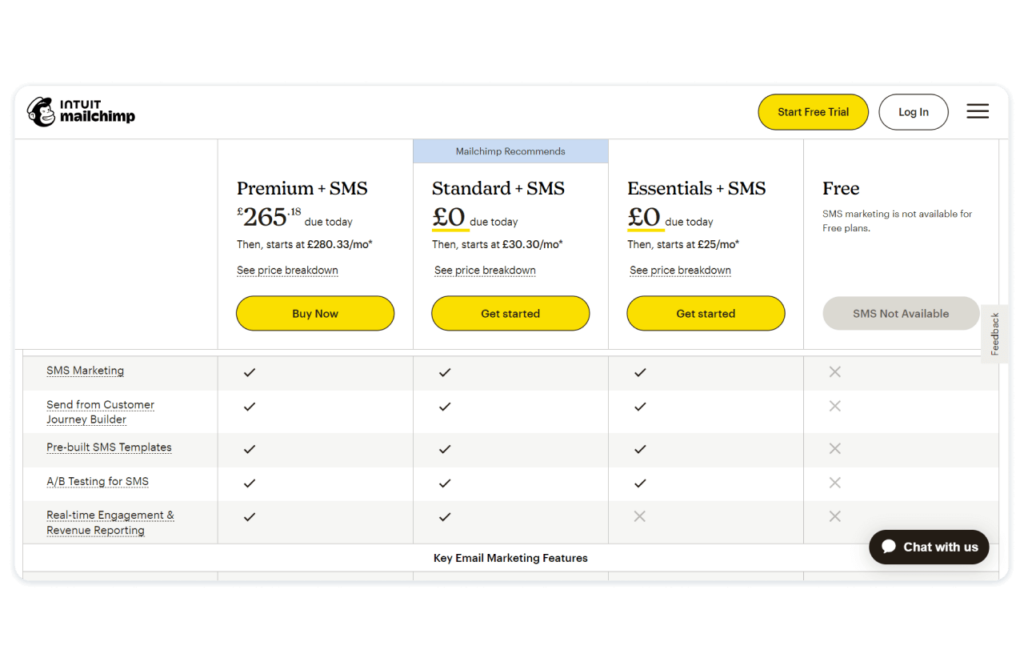
Flat-rate SaaS pricing model
Pros
- Easy to understand for customers.
- Simplicity attracts users who dislike complex pricing schemes.
- Great for products with consistent, stable use across customers.
Cons
- Doesn’t cater to users with differing needs or budgets.
- Heavy users get more value, while light users may feel they’re overpaying.
- Harder to upsell without creating additional products or services.
The flat-rate SaaS pricing model is perhaps the most straightforward of them all. Here, you offer a one-size-fits-all approach. Everyone pays the same price for your product, regardless of company size, users, or features they’re using. Customers get access to everything at one simple price.
This pricing model is the easiest to communicate to your customers and removes some of the complications of other pricing models that may have been putting customers off. Of course, with this simplicity, there are some sacrifices.
Some customers may feel like they’re paying for things they don’t need, while heavy users get more value for money, creating an imbalance.
This approach is perfect for products that provide the same value for all customers, regardless of how many users or features are involved. It also works for simple tools that don’t have many modular features.
A great example is project management software Basecamp, where everyone can benefit from the same set of tools without needing to pick and choose features. They’ve been a champion of this model for many years now, and their customers seem to appreciate the simplicity.
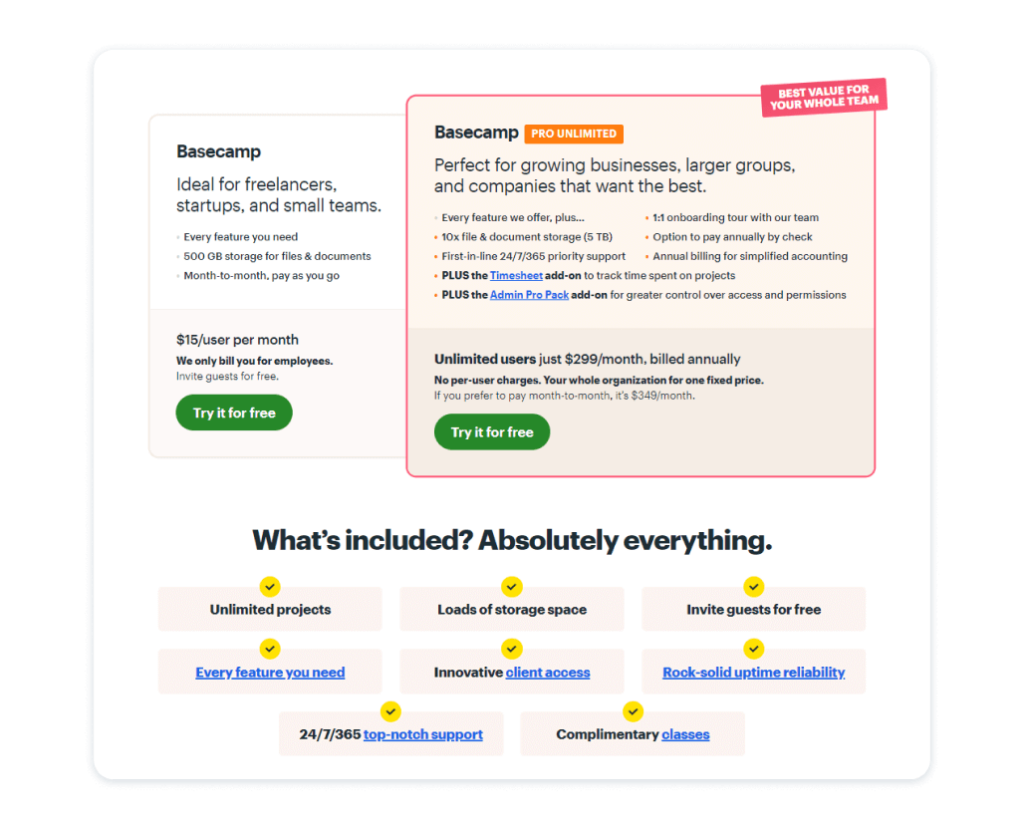
Per-user SaaS pricing model
Pros
- Great for companies scaling or managing fluctuating team sizes.
- Aligns price with actual usage, so customers feel they’re getting value.
- Encourages adoption without making companies pay for inactive accounts.
Cons
- Pricing can be unpredictable for customers with fluctuating activity.
- This can lead to cherry-picking who gets to use the software to cut costs.
- Per-user pricing may leave customers feeling penalized for growth.
Per-user is a SaaS pricing model where you charge your customers for every registered user on the tool. This means that larger businesses with more users will be paying more than smaller businesses with fewer users logged on and registered.
This is a good way for your product to remain scalable for your customers, as they can add new users as they grow, making the tool useful for any size of organization. The issue is that per-user pricing can get pretty expensive for the customer, especially if they have many dormant accounts or users not logging into the tool. Even if the tools have not been used for months, if there’s a registered account, they’re still charged for this.
As expected, this approach can cause frustration, so now many SaaS providers that have used per-user pricing have moved to per-active-user pricing. This is a much fairer pricing model, as customers are only charged per user that has actually logged in and used the service within a specific timeframe. This benefits companies that have a fluctuating team size or usage patterns.
From a PM’s point of view, per-active-user pricing is great for products that are used by large teams where activity can vary, such as messaging tools, collaboration platforms, and project management software. Slack is a fantastic example of this pricing model, while also using tiered pricing plans. Each plan is charged per person per month, indicating a per-user pricing model.
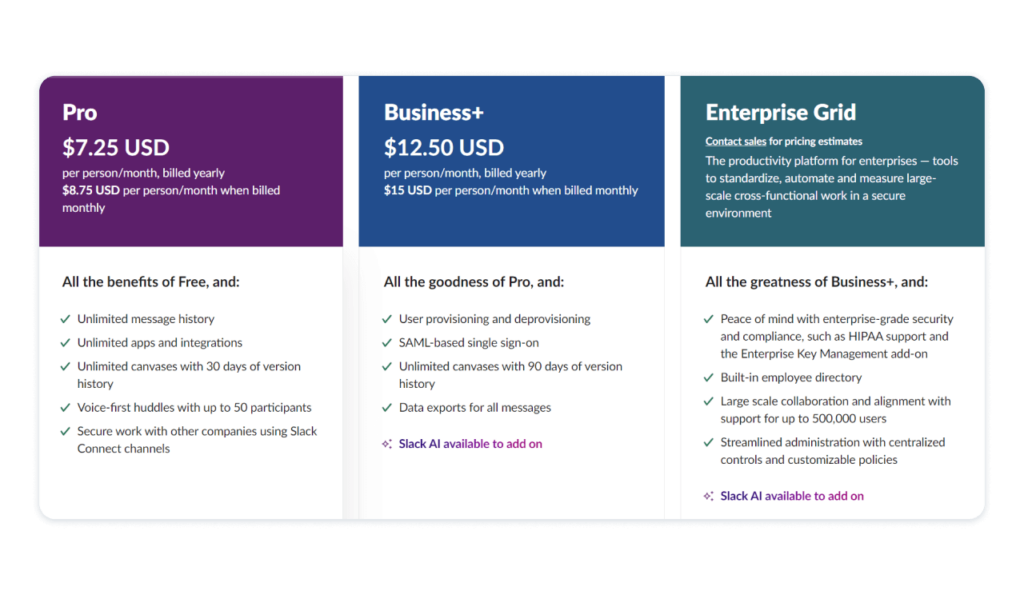
Per-feature SaaS pricing model
Pros
- Allows customers to build exactly what they need without overpaying.
- Ideal for businesses with highly specific feature demands.
- Easier to upsell new features as they’re rolled out.
Cons
- Can be overwhelming for users to choose.
- Complex pricing can make it harder to predict costs.
- Risk of feature fatigue where users are unsure which features they actually need.
In the per-feature pricing model, customers pay based on the specific functionalities they need. It’s like ordering a pizza – you pick and choose the toppings (or in this case, the features) that matter to you. Want a simple yet delicious cheese pizza? You’ll pay less than someone else having a meat feast with stuffed crust added to it.
This SaaS pricing model is fantastic for businesses with very specific needs or for products where not all users require the full suite of features. This flexibility is a huge plus, but it can also overwhelm customers who might struggle to decide which features they actually need. It can also lead to feature fatigue, where users feel pressured to add more bells and whistles just because they can.
Still, this approach is great for products that have modular product architecture and where different types of customers will be using different functionalities. Helpdesk systems and analytics platforms are best suited for this type of model. At ProdPad, we use an adapted version of per-feature pricing where users can pick and choose the key functionality they need. Although not 100% per feature, we think this modular approach is a great example. Go have a look at our pricing page to see how we’ve approached this modular SaaS pricing model.
Check out ProdPad’s modular pricing
For a more traditional per-feature approach, Zendesk nails this model by offering various support functionalities – some customers only need a basic helpdesk, while others need multi-channel support, analytics, and automation.
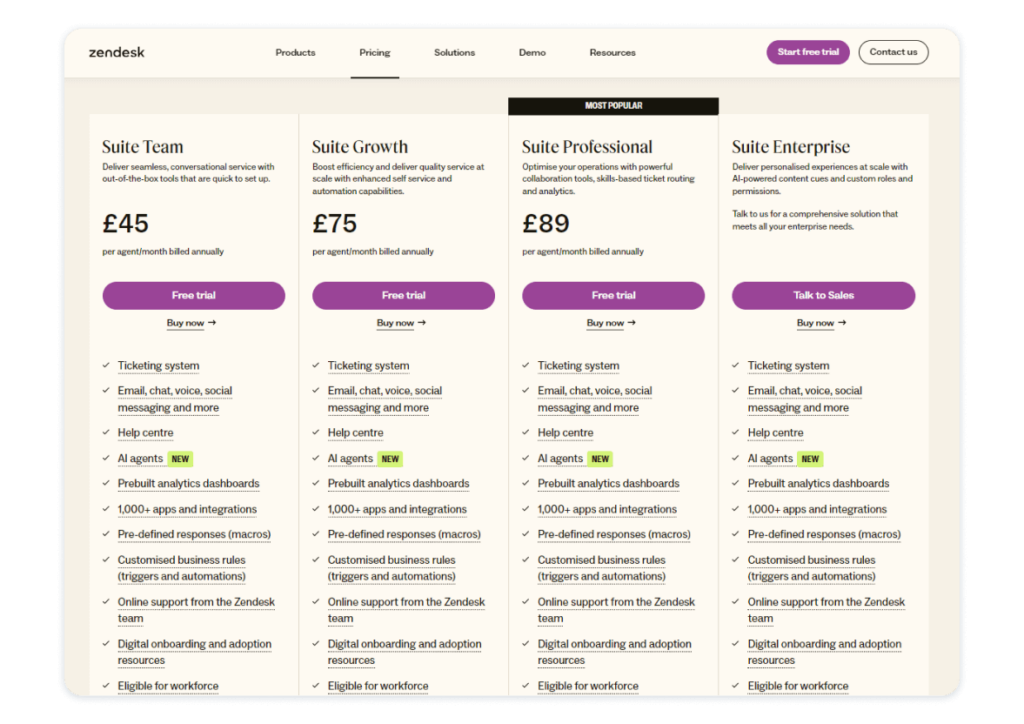
Usage-based Pricing
Pros
- Scalable – users only pay for what they use.
- Low upfront costs, making it attractive for startups.
- Easy to justify ROI since billing aligns directly with usage.
Cons
- Difficult to predict monthly costs, leading to bill shock.
- High-volume users can rack up hefty charges, leading to frustration.
- Risk of customer churn if usage fluctuates too much or they outgrow the need for the service.
Usage-based pricing is the epitome of ‘pay per use’. Customers are billed based on how much they actually use the product, making it ideal for businesses with fluctuating demand. This model is particularly popular in cloud services as you’re charged based on how much data you’ve stored.
The beauty of this model is its scalability. Startups can use as little as they want, while enterprises can ramp up usage without needing to negotiate complex contracts. However, the downside is that usage can spike unpredictably, leading to higher-than-expected bills, and bills that can’t easily be budgeted for from month to month. This model works best when users are well aware of their usage patterns and can plan accordingly. Cloud services, data storage platforms, and infrastructure-as-a-service companies like AWS thrive on this model, allowing users to scale their usage (and their costs).
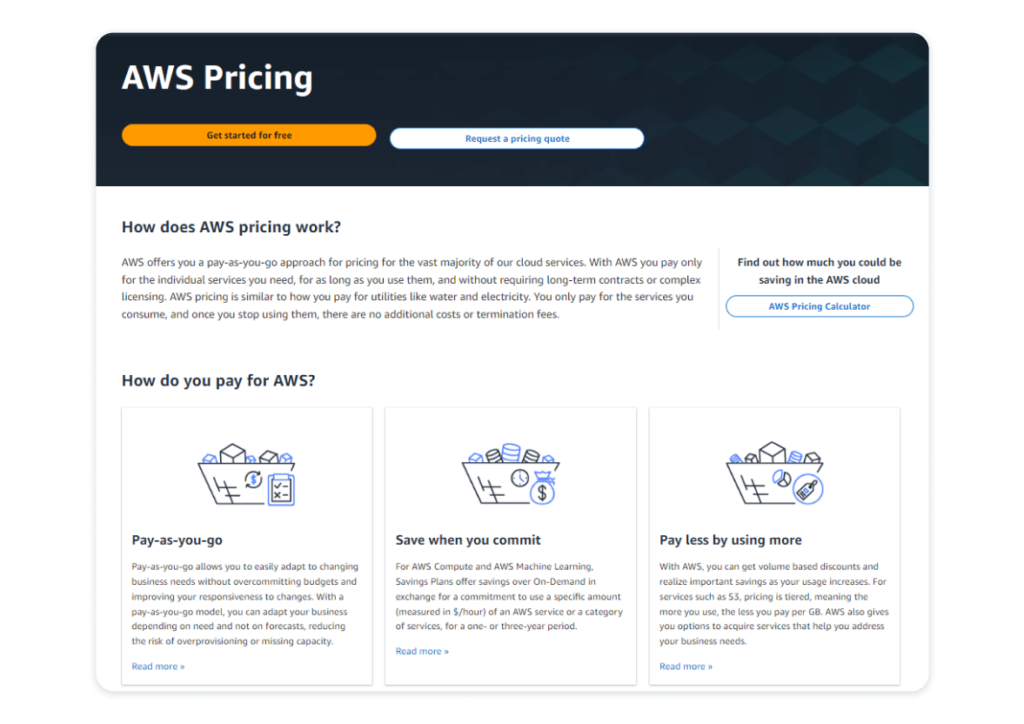
Blended pricing
Pros
- Increased flexibility as you can to cater to a wider range of customers.
- Gives you access to multiple revenue streams.
- Creates a natural path for upselling.
Cons
- Can confuse customers if you have too much of a mix.
- Blended pricing requires more oversight making it harder to manage.
Blended SaaS pricing models, also known as hybrid models combine two or more pricing models together – cherry-picking the best features of each to create a bespoke and tailored pricing option.
You’ll find that most SaaS products use a blended approach, combining things like tired pricing with per-user models. By going with a blended SaaS pricing model, you allow your product to be more versatile and create a product that’s a better fit for your customers.
Blended SaaS pricing models are best suited to products that serve a diverse customer base that has varying needs, as this hybrid approach can allow you to cater to all your audience segments. It’s also best suited to products that have a modular product architecture so that your features can be sold separately or on a pay-as-you-go basis.
A great real-life example of a hybrid SaaS pricing model is HubSpot. They offer a freemium CRM platform but give you the option to pay for specific modules that best suit your needs, making their pricing a blend of freemium and per-feature pricing.
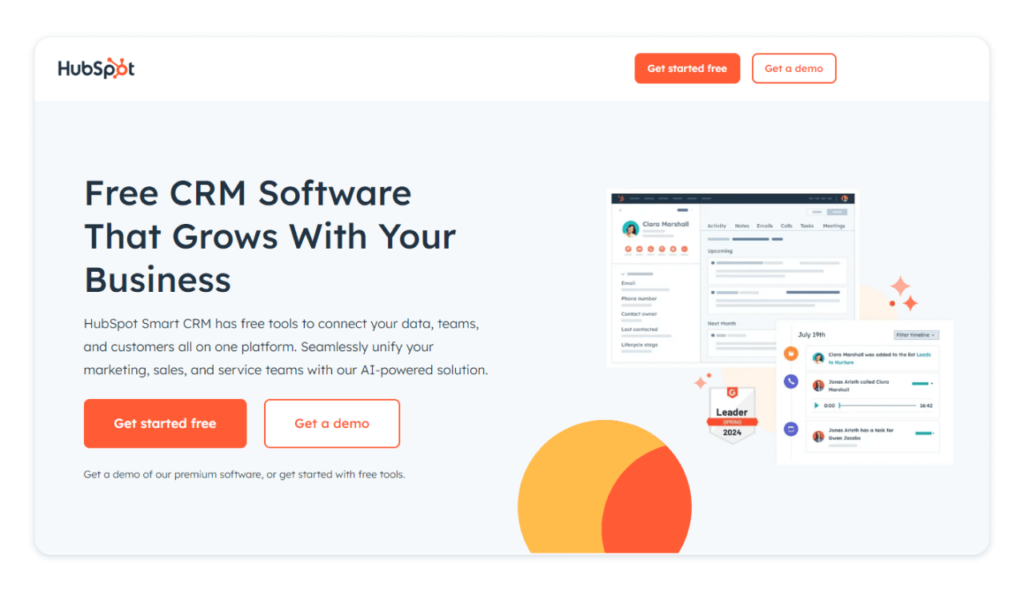
Your next top model
Choosing the right SaaS pricing model is not just about picking one that seems appealing – it’s about aligning your model with your overall business goals, customer expectations, and market demands. As we’ve seen, there are many options to explore, from the widely popular freemium and tiered models to the more nuanced usage-based and per-feature models. Each comes with its own set of pros and cons, making it essential to weigh them against your company’s specific needs and audience.
The beauty of SaaS pricing is its flexibility, but with that comes the challenge of ongoing experimentation. Don’t be afraid to test, iterate, and optimize your pricing model as your product evolves. Factors like customer feedback, market shifts, and even internal growth can all signal that it’s time to revisit how to price your product. Remember, pricing is never a “set it and forget it” task; it requires constant tweaking to stay competitive and relevant. The SaaS pricing models you use need to be flexible. Be sure to use product management tools that are equally as adaptive.
With ProdPad, you can get features that best suit your needs, be it roadmapping in our Now-Next-Later framework, tracking customer feedback, and highlighting recurring ideas to find out what you should be working on next. Find out which ProdPad features work best for you. Book a demo and see how ProdPad can help you.
Learn how ProdPad can work for you.
thanks for info.